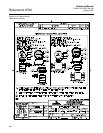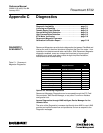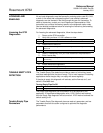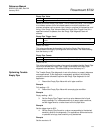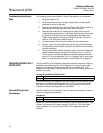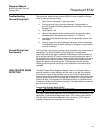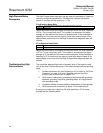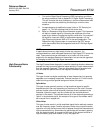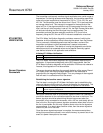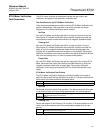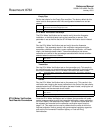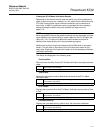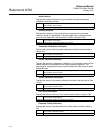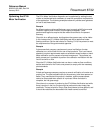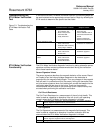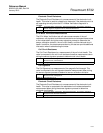
Reference Manual
00809-0100-4663, Rev BA
January 2010
Rosemount 8732
C-8
The transmitter continuously monitors signal amplitudes over a wide range of
frequencies. For the high process noise diagnostic, the transmitter specifically
looks at the signal amplitude at frequencies of 2.5 Hz, 7.5 Hz, 32.5 Hz, and
42.5 Hz. The transmitter uses the values from 2.5 and 7.5 Hz and calculates
an average noise level. This average is compared to the amplitude of the
signal at 5 Hz. If the signal amplitude is not 25 times greater than the noise
level, and the coil drive frequency is set at 5 Hz, the High Process Noise alert
will activate indicating that the flow signal may be compromised. The
transmitter performs the same analysis around the 37.5 Hz coil drive
frequency using the 32.5 Hz and 42.5 Hz values to establish a noise level.
8714I METER
VERIFICATION
The 8714i Meter Verification diagnostic provides a means of verifying the
flowmeter is within calibration without removing the sensor from the process.
This is a manually initiated diagnostic test that provides a review of the
transmitter and sensors critical parameters as a means to document
verification of calibration. The results of running this diagnostic provide the
deviation amount from expected values and a pass/fail summary against
user-defined criteria for the application and conditions.
Initiating 8714i Meter Verification
The 8714i Meter Verification diagnostic can be initiated as required by the
application. If the advanced diagnostic suite (D02) was ordered, then the
8714i Meter Verification diagnostic will be available. If D02 was not ordered or
licensed, this diagnostic will not be available.
Sensor Signature
Parameters
The sensor signature describes the magnetic behavior of the sensor. Based
on Faraday’s law, the induced voltage measured on the electrodes is
proportional to the magnetic field strength. Thus, any changes in the magnetic
field will result in a calibration shift of the sensor.
Establishing the baseline sensor signature
The first step in running the 8714i Meter Verification test is establishing the
reference signature that the test will use as the baseline for comparison. This
is accomplished by having the transmitter take a signature of the sensor.
Having the transmitter take an initial sensor signature when first installed will
provide the baseline for the verification tests that are done in the future. The
sensor signature should be taken during the start-up process when the
transmitter is first connected to the sensor, with a full line, and ideally with no
flow in the line. Running the sensor signature procedure when there is flow in
the line is permissible, but this may introduce some noise into the signature
measurements. If an empty pipe condition exists, then the sensor signature
should only be run for the coils.
Once the sensor signature process is complete, the measurements taken
during this procedure are stored in non-volatile memory to prevent loss in the
event of a power interruption to the meter.
375 Transducer Block, Diagnostics, Advanced Diagnostics, 8714i Meter Verification
AMS Tab Diagnostics
375 Transducer Block, Diagnostics, Advanced Diagnostics, 8714i Meter Verification,
Sensor Signature, Re-Signature
AMS Tab Context Menu, Diagnostics and Tests,



